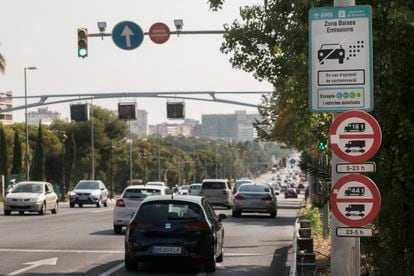Access to Barcelona through Avinguda Diagonal, with signs for the Low Emissions Zone, in a file image.MASSIMILIANO MINOCRI
Barcelona gives a new twist in the fight against pollution caused by traffic and opens a new debate: urban tolls.
Neighborhood organizations and environmentalists from the Catalan capital have put on the table a toll like the one that cities like Milan, London or Stockholm have had for years.
The proposal seeks to dissuade the individual use of the car and would mean paying four euros a day to vehicles that circulate with only one or two occupants, which would reduce traffic by 21%, they say, and enter 370 million euros that would be used to improve public transport, bike lanes and 10% to public health.
The proposal comes when dozens of Spanish cities are preparing Low Emission Zones (ZBE), spaces banned from the most polluting cars, as provided for in the Climate Change Law for the 149 towns with more than 50,000 inhabitants (or those with 20,000 with more pollution) before the end of this year.
Barcelona implemented its ZBE in 2020 and is no longer giving itself away: it has achieved the objective it set itself, to reduce nitrogen dioxide (NO2) emissions by 11% and reduce the most polluting vehicles from 20% to 4% of the circulating fleet .
More information
Toll of four euros per day for cars with one or two occupants: the measure against pollution of residents and environmentalists in Barcelona
One year before the municipal elections of May 2023, the mayor of Barcelona, Ada Colau (BComú), does not plan to tighten the current restrictions, although her government has studied new actions, among which are the toll and prohibiting the circulation of vehicles with a yellow label from the General Directorate of Traffic.
Now, the cars, motorcycles or vans that cannot enter are those that do not have a label.
Meanwhile, and given the City Council's lack of calendar, entities such as the Platform for Air Quality, Eixample Respira (promoters of the school revolt to protect schools from pollution and noise) and Ecologists in Action, take a tour of nut and have launched their urban toll proposal.
They criticize the "inaction" of the administrations and seek to put pressure on them.
From Eixample Respira, Guille López recalls that "69% of the private cars that enter or leave the city travel between areas where the metro, tram or train arrives" and that "the average occupancy of the vehicles that circulate in Barcelona is of 1.19 people”.
The toll "is the most effective measure to discourage car use," he adds, noting that it works in 19 European cities, with reductions of up to 30% in traffic.
“The message is that a one-ton car driving with a 80-kilo person is a privilege: we do not prohibit you from driving, but you must compensate for the environmental costs,” he defends, and assures that four euros would be “in the low range” of the pollution tolls existing in Europe.
In Barcelona, the implementation area of the toll would be the same as the ZBE (almost 100 square kilometers that comprise Barcelona and part of its adjoining municipalities) and contemplates that any vehicle that circulates with one or two people pays four euros a day.
It would not be a physical toll, with barriers, but would be controlled by cameras that read license plates (you would have to pay the day before) and the Urban Guard.
Emergency vehicles, special vehicles, people with disabilities or low incomes who need the car to work would be exempt from the rate.
On the other hand, the proposal does include carriers, delivery people and professionals who need a vehicle to work (plumbers, plumbers, carpenters, etc.).
The employers of the motor, carriers, merchants, hoteliers, restaurateurs and commercial agents have already shouted to the sky.
Also entities such as AsoPARC, affected by movement restrictions.
In fact, the bulk of the employers' associations or associations that reject the toll are those that appealed to the ZBE.
An appeal they won: the justice annulled the ZBE for "excessive", but it is still in force because it can be appealed.
The City Council has already filed an appeal before the Supreme Court and, meanwhile, the entities that took the ZBE to court ask to provisionally execute the annulment.
From the Official Association of Commercial Agents, its director, Jordi Martí, understands that “personal and professional mobility cannot be put in the same bag.
Taking the child to
school
by car is not the same as waiting for an order”, he says, adding: “You cannot make workers that the city needs to function pay a toll for low occupancy.
The commercials go alone in the car”.
The Guild of Transport and Logistics of Catalonia recalls that “every day 30,000 vans and trucks enter Barcelona”.
"It is a public service," emphasizes its president, Antonio Martínez, who adds that 80% of them are self-employed workers and "they are very affected by the rise in diesel."
Colau has already responded that he will study the proposal, "because the current pollution and the fact that 1.6 million cars circulating in Barcelona are from abroad is unsustainable."
The mayor understands, however, that it should be done "with a broad consensus" and together with the Metropolitan Area (which brings together the capital and the 35 municipalities that surround it) and the Generalitat.
In the rest of Spain, neither Madrid, nor Seville, nor Valencia raise tolls against pollution.
In Madrid, they rule it out, point out sources from the Environment area.
The plan of the mayor José Luis Martínez-Almeida (PP) goes through deploying Madrid 360: 21 rings with the aim of prohibiting the circulation of cars without a label in 2025. The last change began on May 1.
From this day on, cars without a label from outside Madrid cannot access the perimeter of the M30.
In Seville, the mayor, Antonio Muñoz (PSOE), has recently ruled out the toll: "The application of this measure is not part of the municipal government's intentions."
One year before the elections it is an uncomfortable issue and Córdoba or Málaga are in the same position.
In 2020, Seville launched the Respira plan to promote sustainable mobility and reduce emissions.
In July it will restrict traffic in the old town and the whole of Triana to neighbors and clients of hotel and tourist establishments.
In episodes of high pollution, the low emission zone that includes Seville and part of its surroundings does not allow vehicles without a label to circulate.
The Seville Platform for Climate requires the city council to control access to the low emission zone before 2023.
In Valencia, the mayor Joan Ribó (Compromís), rules out implementing an urban toll because it would affect, he considers, people with lower incomes.
"We don't like it," said the mayor.
Meanwhile, the Department of Sustainable Mobility, directed by Giuseppe Grezzi, is about to put out to tender the technical structure to implement the Low Emission Zones.
And in parallel, Las Naves, a municipal innovation space, has subsidized a pilot study promoted by the Mesura Association that precisely proposes to implement an eco-tax in the city.
A pilot plan to which the Valencian City Council is not linked, at least for now.
The emeritus professor of Environmental Engineering at the Polytechnic University of Catalonia, José María Baldasano, staunch defender of Low Emission Zones, values the idea of an urban toll in Barcelona, but framed in other actions such as improving public transport or rethinking the urban distribution of goods.
“The metropolitan tolls implemented from the 1960s did not discourage the use of the car, but at the urban level it can work and there are clear experiences of reducing the flow of vehicles, but you have to think about it carefully so as not to affect the working classes, as it happens with the ZBE”, he points out.
"In any case, it should be accompanied by a substantial improvement in metropolitan public transport and a plan for the last mile of delivery."
In a similar vein to Baldasano, CSIC researcher Xavier Querol recalls that his Air Use project, awarded by the European Commission, contemplated a package of measures to reduce pollution in any city that includes tolls: "We proposed several phases to improve quality from air.
Metropolitan public transport, urban tolls and allowing only street parking for residents, ZBE, improving the distribution of goods, and urban redesign”.
In Milan the traffic has been reduced by 35% since 2015 and in Stockholm the same figure since 2007.
Javier Ortigosa, civil engineer and doctor in traffic engineering, starts from the premise that reducing the number of vehicles in a city "not only implies improvements in health and public space, but also has positive impacts on the entire transport system regional public.
Ortigosa is in favor of "acting on demand, establishing charging mechanisms that reduce traffic without generating congestion", and cites "regulating the price of parking, or establishing tolls to circulate or enter and exit a city".
The cities that have applied toll mechanisms have achieved reductions of more than 20% in traffic, he recalls, "which also brings benefits to public transport systems, energy and health spending."
With information from
Manuel Viejo
,
Eva Saiz
and
Cristina Vázquez
.
In London, Stockholm and Milan, carriers also pay the fee
In the congestion or pollution tolls of London (United Kingdom), Stockholm (Sweden) and Milan (Italy), all prior to 2010, delivery vehicles also pay the fee.
In London there are two crowns.
The Congestion Charge, from Monday to Friday from seven in the morning to six in the afternoon, which covers the equivalent of zones 1 and 2 of public transport, in the center, costs 15 pounds (17.70 euros) per day, with a 90% discount for residents.
In a broader perimeter, the ULEZ (Ultra Low Emission Zone) has been established, which affects the most polluting vehicles (20% of those that circulate), reports
Rafa de Miguel
.
This second crown applies any day at any time and has a daily cost of 12.50 pounds (14.70 euros).
Access and payment control is done with cameras that capture license plates and there are discounts for electric vehicles.
In the case of Stockholm, there are also two levels of restriction, Hornsgatan street (central and commercial) and a second, broader perimeter that covers the entire city.
Prices, which are paid when crossing access bridges to the city, range (depending on the time slot) between 10 and 13 euros per day in the most restricted area and 1 and 4 euros in the largest.
The exceptions to the toll are emergency vehicles, buses, diplomatic vehicles, motorcycles and military vehicles.
In Milan, the restriction is applied in the center, completely vetoed to the most polluting cars.
The rest, on weekdays during working hours, pay five euros to enter;
two euros in the case of residents.
You can follow CLIMA Y MEDIO AMBIENTE on
and
, or sign up here to receive
our weekly newsletter
Exclusive content for subscribers
read without limits
subscribe
I'm already a subscriber








